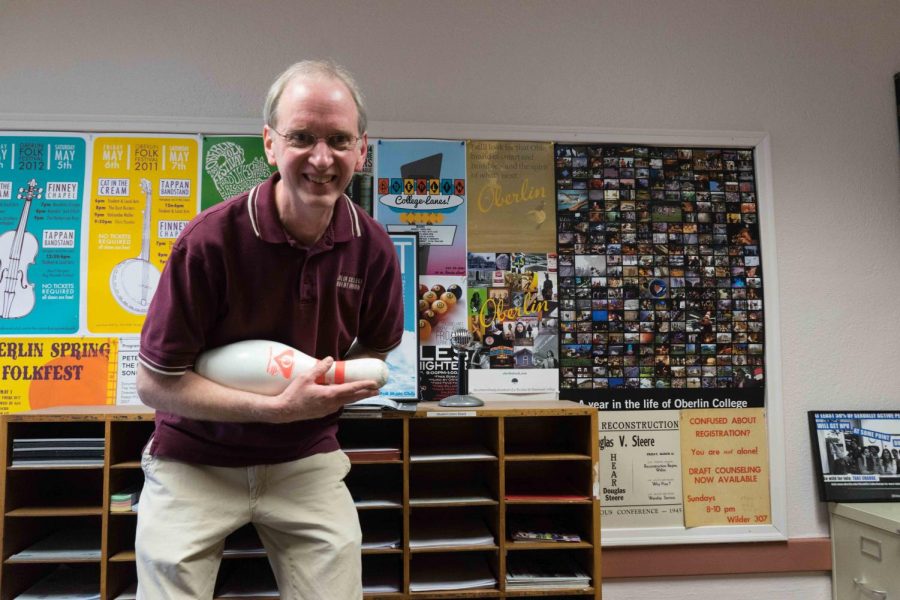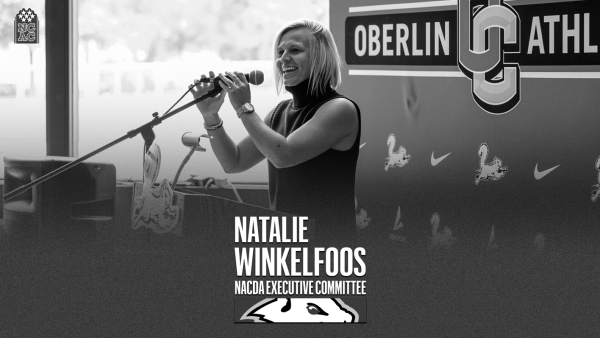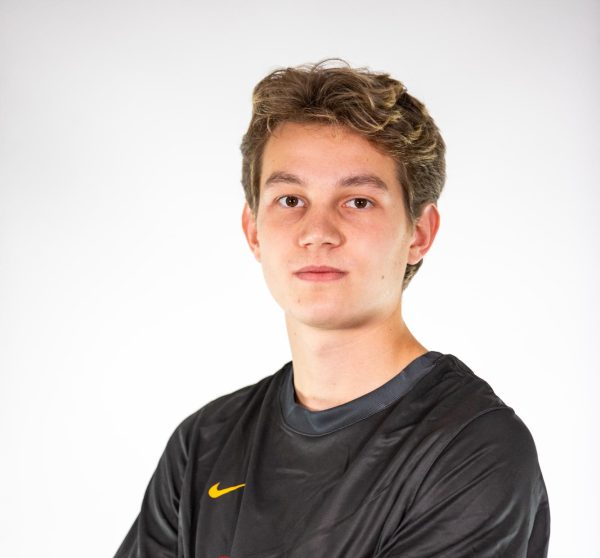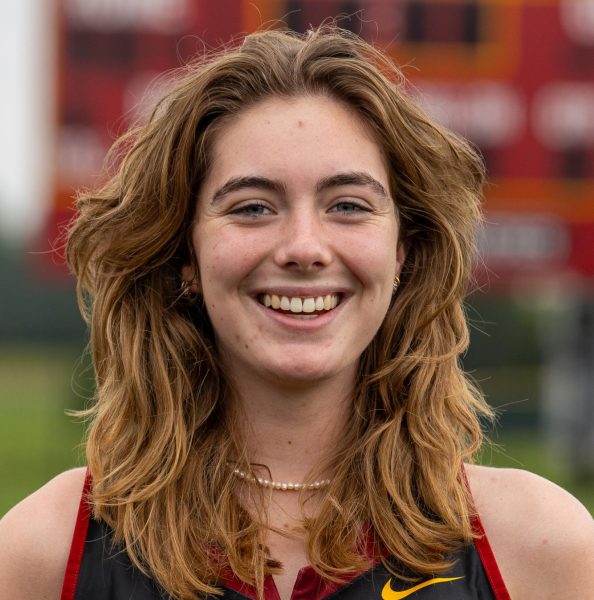In The Locker Room with Tom Reid, Bowling Coach, Mentor
Tom Reid, OC ’80, Bowling Coach.
Tom Reid, OC ’80, came to Oberlin College in 1976 from the small city of Wilkes-Barre, PA — but that wasn’t his first choice, as his plan was to bowl professionally. Fortunately for Reid, half of his dream ended up coming true when he discovered the Oberlin College Lanes. After 45 years of participating in the sport and 84 consecutive semesters at the College, Reid has coached the bowling team that he founded shortly after he graduated and instructs the Bowling I and II classes. The team averages around 15 members per season and competes in seven tournaments a year. Tomorrow at noon the College Lanes will host its 20th annual OC Unconventional tournament, which will feature the Oberlin bowling team and teams from Kent State University, the University of Akron, the University of Toledo, and Lorain County Community College. Students interested in joining the team are welcome to participate at Monday’s team practice at 4:30 p.m. at the College Lanes or can email Reid at Tom.Reid@oberlin.edu or bowling@oberlin.edu.
This interview has been edited for length and clarity.
How and when did you become involved in bowling?
My church was forming a bowling league, and I asked my parents if I could join. I figured they’d say no, but they said yes. I was one of the those kids who was picked near the end in gym class whenever we would be choosing sides for basketball or anything, so I did not have a self-image as someone who was at all athletic, even though I wanted to be a Major League Baseball player. My best friend at the time — who was one of those naturally gifted people who is really good at everything the moment they first try it — also signed up for the bowling league. The first week, I beat him by a few pins. That was cool, but when I beat him again the second week, I thought, “Hey, this might be the thing I’m good at.” I got way into it, and by the end of high school I was bowling six leagues a week. I didn’t want to go to college. I just wanted to bowl.
When and why did you decide to create a team at Oberlin?
Fortunately I came to a school that had bowling lanes on campus, and during my first semester here, a woman who was teaching a bowling class put together a team to go to a tournament out in Cleveland. I was recruited for that team, and we drove into Cleveland one Saturday, bowled three games, and finished in second place. I was second in singles, and that was the only intercollegiate bowling opportunity that I had as a student. I did not know that there was this whole world of intercollegiate bowling competition out there until the semester after I graduated, when I came back to manage the lanes and started getting all of the mail that comes to the lanes. I wish I would have known. In this classic “make it better for the people who come after you” [opportunity], I knew I had to form a team. Our first tournament was the [Association of College Unions International] tournament. It was at Kent State University in the spring of ’81, and I’ve had a team ever since.
Who typically joins the bowling team? How do students find out about it?
We do not draw many students to Oberlin who are already bowlers. The high school students who are serious bowlers usually want to go to a school that has one of the top bowling teams. We are growing bowlers from the ground up. There are a lot of programs at the lanes that feed off of each other. There’s the free bowling for College students every Tuesday afternoon at 3:30 p.m. until 6 p.m. There are intramural leagues on Wednesday nights and Sunday nights. There are the bowling classes — lots of different entry points. One of our biggest ones is actually the club sports fair at the beginning of the year, and particularly this year and last year, we’ve had several first-years sign up with the bowling team who have never really bowled before — maybe at a birthday party when they were like 10. They’re really not bowlers, but they’re looking for a community to become a part of. They found it with the bowling team and have stayed with it. It just warms my heart. Last year, several of our new members were women, and that allowed us to field a women’s team for the first time in 10 years.
Why is it so important for students to have a sense of community and some form of an outlet, like bowling?
I think it’s important that we help students to be of sound body as well as sound mind. The bowling lanes attract a lot of students who would never go to the gym, and we sort of trick them into being physically active. I like to think that our program is helping bridge the athlete/non-athlete divide.
How has coaching the team allowed you to connect to the student body on a deeper level?
When you work with someone repeatedly, you really build a connection there. I lead a practice for the team for an hour and a quarter every Monday afternoon, but when we travel to these tournaments and we’re going on a road trip together and eating at a restaurant together, you form close bonds. Many of the people who were team members early on back in the ’80s and ’90s are still close friends of mine, and we stay in touch. They often come back to Oberlin, which helps them connect to the institution as well. We have our alumni game — or “funraiser” — on Saturday morning of commencement weekend. Our 29th one will be coming up this year, and the students lead the match 15–13 overall, so it’s still pretty close. Bowling helps keep people engaged with Oberlin long after they were students here.
What are some of the best moments you or the team has experienced this year so far?
What really stands out to me this year is our newer students who just started bowling. Two bowlers, one on the men’s team and one on the women’s team — [College senior] Julian Meltzer and [College sophomore] Clare Curry — really stand out to me. I was just so impressed with these folks at [a couple of the tournaments]. In Julian’s case, it was his first tournament ever, and he was really nervous and didn’t do very well at the start, but he was so focused and determined to make it work. He made a string of really good shots. In Baker bowling, you typically put your best bowler last — in the anchor spot. They have a chance to roll four strikes in a game, while everyone else has an opportunity to roll two. In the 10th frame, if you roll a strike, you get to keep on going. Julian was doing so well that I put him in the anchor spot in the very first Baker game and just left him there all day. In another tournament, Clare had not yet demonstrated a higher level of control over where the ball was going. But in that tournament, she was playing the lanes as they transitioned and was moved to the anchor spot. I hate to single out those two, because this is just typical of what happens to Oberlin bowlers when they go to these tournaments, but every year there are just instances like that that make me so proud.










